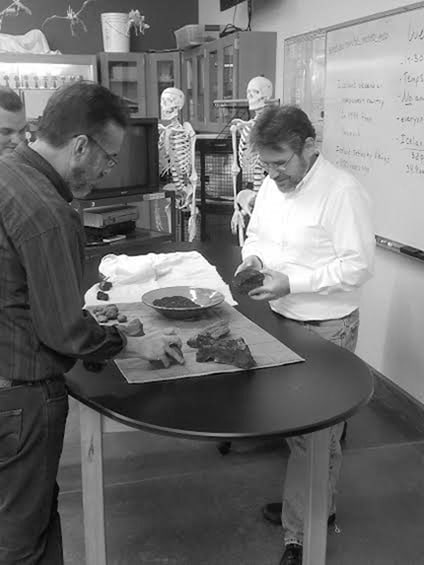Biology professor Dr. Edward Zalisko and his wife Amy recently journeyed to Iceland to observe the geological effects of the Mid-Atlantic Ridge. Zalisko presented his story of the trip detailing their observations to students and faculty on Sept. 26.
This expedition is the latest of a series of summer trips Zalisko has taken; however, these trips are not simply vacations for Zalisko.“It’s not about a bucket list or a check list, but it’s about really trying to see the world to understand the world around us,” he said. Each journey he and his wife take is another pursuit to continue their education and help teach their students. In this case, Iceland was chosen due to it being the only island on the Mid-Atlantic Ridge as well as its glacial influences. Zalisko’s presentation consisted of slideshows with him explaining what each picture meant and narrations of his trip.

Dr. Zalisko presents several specimens of volcanic material he and his wife collected from Iceland
The trip to Iceland lasted June 14-30, during the height of the summer there. As such, the time spent in Iceland was under constant sunlight. Zalisko’s journey skirted the entire perimeter of Iceland in order to experience the different areas of the island and see how the glaciers and volcanic activity changed the landscape.
According to Zalisko, Iceland is a hub of volcanic activity due to its position on the Mid-Atlantic Ridge, the boundary between the North American and Eurasian tectonic plates. This ridge is slowly spreading apart, resulting in the plates creating new land masses via magma hardening. As such, Iceland is covered in fumaroles, geysers, hot springs and volcanoes. The level of geothermal energy is to the point in which Iceland simply pipes hot water to many of its cities to use without the need to heat it.
In addition to the geologic activity below Iceland, the surface has been host to massive glaciers that have further altered the landscape. These glaciers carve swathes through the land, creating valleys and fjords until they reach the sea. Where the glaciers and volcanic activity meet, swift changes are made in the landscape as either massive floods erupt from melted glaciers or the ground shifts due to steam expanding inside it. The runoff from these glaciers, along with the snow, melt in the summer, leads to Iceland being covered in a stunning amount of waterfalls and rivers. Zalisko described one of these remote fjords as his favorite experience in Iceland, specifically the western fjord known as Borgarfjörður because “It was in every way an inspirational place. It was so peaceful.”
The next trip Zalisko plans to take is to the island of Newfoundland in Canada in order to further study geology. He plans to visit Mistaken Point National Park due to its unique fossils and its “wild” environment.

